Product Requirements:
Device:
Sharp Official Support: Windows PC 98, 2000, ME, XP
or later
Unofficial Support: Mac OSX file transfers thru free 3rd party OSX
USB Driver or storage cards, possible sync support in future thru 3rd party
OVERVIEW
The recently released in Japan Sharp Zaurus SL-C760 is the current top of the
line in the Zaurus line. Sharp also released a Zaurus SL-C750 that is the same
basic design with less memory, smaller battery, and black color casing around
the display (instead of white as on the C760).
The SL-C760 has several things going for it that make this the best PDA I’ve
ever had and I’ve had lots! This includes several Newtons, some WinCE HPC’s,
several PPC’s, Palms, Handsprings, and in the past 2 years, several Sony Clies.
The SL-C760 has much more going for it than yet another PDA hitting the already
crowded PDA market. Rather, you should think of it as more of a mini-computer
than a regular PDA. It has the usual PDA functions; calendar, contacts, ToDo
List, text editor, and calculator apps. So, if all you want is to use it as a
PDA, you can do that and be fairly happy with it. Although, if all you want is a
device to store calendar and contact info, you’re probably better off buying a
PDA made for the USA market.
If you just use the C760 for basic PDA stuff, you’ll be missing out on some of
the more advanced, powerful, and unique features of the SL-C760.
What makes the SL-C760 (and its siblings the SL-C750, SL-C700, SL-5600 and
SL-5500) unique from other PDA’s on
the market is the use of Linux, the open source based OS, called Linux OpenPDA.
This is basically the same Linux that is used to run desktop and laptop
computers with some modifications to allow for the smaller display and memory
sizes.
You can access or use Linux commands on the C760 by running the Terminal app.
Running Terminal you can type in Linux commands at a command line prompt. This
allows you to run your C760 from the Terminal, modify or install new custom
ROM’s, or other geeky stuff like Telneting into another computer, and even write
software code and compile it on the C760!
Also, the use of Linux means that the Zaurus has become an attractive platform
for the Linux development community. So I soon became aware there is a lot of
third party software out there for the Zaurus. Since the C7xx series is
relatively new there isn’t as much software that is specifically written with it
in mind. However, I’ve found that most of the 5500/5600 series software will run
on the C7xx series.
One of the largest third party Zaurus software developers,
theKompany.com has already released C7xx
versions of most of their apps.
Unlike previous models (5500/5600) you need to install the Terminal program from
the supplied CD. This is a must if you’re going to convert the C760 to English
yourself. See the section titled ‘Warning!’ later on in this review for more
about that….
Hardware Specifications
OS Linux OpenPDA
CPU Intel Xscale PXA255, 400 Mhz
Memory 128 MB flash memory (64 MB on C750)
±65 MB available due to included Japanese Dictionary*
64 MB SDRAM (work area)
Display VGA 640 x 480 pixels, 3.75 inch, 65536 colors, transmissive LCD with
backlight and touchscreen
Connectors I/O port
Stereo headphone jack (3.5 mm)
IrDA, 115 kbps
AC power adapter jack
Card Slots (1) SD slot (memory card only) (1) CF Type II slot (memory cards and
IO cards)
Input Keyboard (individual keys), handwriting recognition, on-screen keyboard,
Japanese character input
Battery Removable, Lithium-ion rechargeable 3.7 V DC, 1700 mA (950 mA on C750)
AC Power 100V, 50/60 Hz, plug w/folding prongs for travel
Size Approx. 4.7” x 3.3” x 0.9” (C750 is 0.7” thick due to smaller battery)
Weight Approx. 8.8 oz. (C750 approx. 7.9 oz.)
*Should be able to reclaim that memory by modifying ROM file to delete the
Japanese Dictionary
What’s In The Box
Sharp Zaurus SL-C760 Personal Mobile Tool
AC Power Cord (no power brick!) with folding prongs
USB Sync Cable
Plastic Stylus
Manual (Japanese)
Sharp Zaurus CD
Small Battery Cover
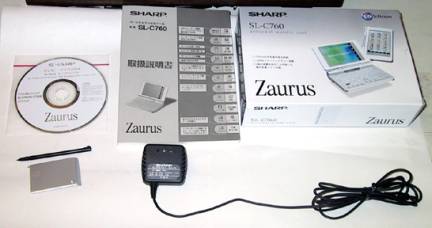
Zaurus SL-C760 & USB Cable not shown in photo
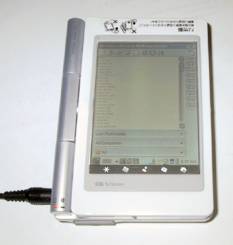
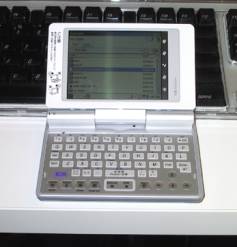
Portrait (PDA) Mode Landscape (Laptop) Mode
FORM & DESIGN
The form and design of the C760 is unique and has obviously inspired the
recently announced Sony Clie UX40/50 line. However, in my opinion, the C760
takes better advantage of its form than the new Sony’s. The C760 has a clamshell
design with a flip and twist design similar to some of the recent Tablet PC’s.
This allows you the flexibility to use the C760 in several ways.
First, you can open it up and use it like a little laptop with landscape display
and keyboard. Or you can use it like a typical Palm or Pocket PC by opening up
the C760 and doing the ‘flip and twist’ motion and then folding it back against
the keyboard half. The C760 automatically senses the change and shows a portrait
display. In this mode, the silk-screened buttons (Calendar app, Contacts app,
Email app, Home window) at the bottom of the display are useful for tapping on
with your stylus.
If you twist and flip the screen back to ‘laptop mode’ the C760 senses the
change and automatically rotates the display back to landscape mode.
In portrait mode, you can input text either using handwriting mode or by tapping
on letters on an on-screen keyboard. There’s a jog wheel and a chrome rocker
switch next to it that you can use for one-handed operation. For example, use
the jog wheel to scroll through text in an ebook or items in a list and then
click on the rocker switch to open the selected item. You can also use the
rocker switch to exit an open file or exit an app.
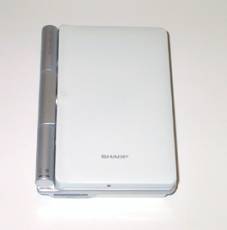
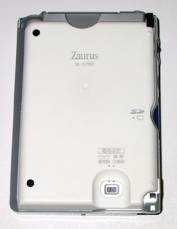
SL-C760 Closed and Backside view with large battery cover, battery cover
release switch, CF card slot at top
In comparison, from what I’ve read online, the new Clie UX40/50 you can flip the
screen back to use a table style PDA but unlike the C760 the screen stays in
landscape mode.
One of the nice things with this type of design is that when the C760 is closed
the display and keyboard are protected.
The size, shape, and weight is very good and the C760 feels just right in my
hands (not real big). Also, it fits in most of my shirt pockets if you want to
carry it without a case.
The C760 has a simple elegant look about it due the use of the crisp white color
with silver hinge and band around the keyboard.
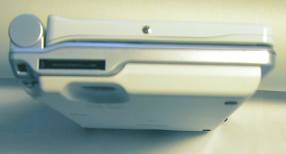
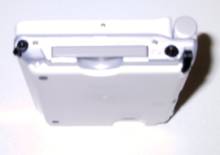
Left Side, Right Side
The right side of the C760 has the stylus slot, the CF card slot (with
plastic removable plug), and the headphone/mic jack. The left side has the
connector slot with plastic removable plug) for the USB cable.
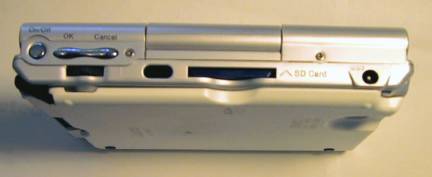
Backside
The back side (where the hinge is) has the chrome On/Off button, the black
plastic jog wheel, the OK/Cancel rocker switch above the jog wheel, Irda port,
SD card slot, and the AC power jack.
The stylus that comes with the C760 is a typical plastic stylus. Nothing to
write home about.
So instead I’m using a metal barrelled Pilot Pentopia collapsing stylus with
ballpoint pen hidden under the top cap. It fits perfectly in the stylus slot.
Much better!
One of the great features of the C760 is that it has both CF and SD card slots.
This allows you the flexibility to use either CF or SD storage cards or a CF
WiFi card and a SD storage card at the same time.
One interesting aspect to the C760 design is that since its form is like a
laptop that sits on your desk there is no need for a cradle. The USB cable just
plugs into the C760 and the other end into your computer. So one less thing to
take or lose on a trip!
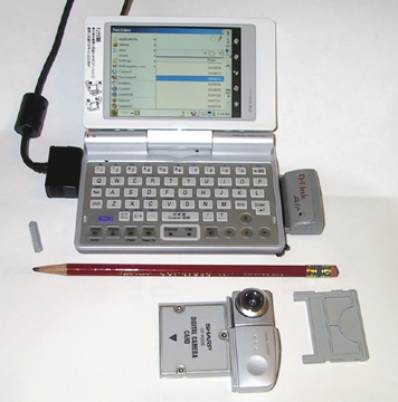
SL-C760 with Sync cable-WiFi Card – CF Card Slot Plug – Optional CF Card
Camera
Some other good things about the design is that the AC power cord has no bulky
‘power brick’ on it and the end that plugs into the power outlet has folding
metal prongs. Both of these design features make the C760 that much better in
traveling.
Another plus is the use of a removable battery. The C760 comes with a fairly
beefy (power-wise) 1700 mA battery while the C50 comes with a slightly smaller
950 mA battery. Either battery may be used on each of the C760/750.
If you use the smaller battery on the C760 then you remove the white plastic
bottom cover and just use the included smaller battery cover. This reduces the
thickness of the C760 a bit.
While I haven’t done any specific tests on the battery, I can say that the large
battery feels like it has adequate power to last through a day or two of fairly
heavy use before needing recharging.
Recharging goes pretty quickly, maybe an hour or two to top off the battery.
The C760 comes with plenty of memory, 128 MB flash memory, with about 65 MB
available due to Japanese dictionary, and another 64MB of user accessible RAM.
On top of all this you can have more memory with CF and SD cards, You can even
run apps from the cards if you format the cards properly.
The 400 Mhz Xscale processor is quite peppy in normal use. It takes about a
second or two for apps to open up after tapping on their icon.
One great feature is the ability to have multiple programs open at the same
time. This can be a real productivity booster.
DISPLAY
One of the most pleasing things about the C760 is the wonderful, bright, clear,
sharp, and colorful display. The resolution is extremely good and looking at
photos on the C760 is a real joy.
The only downside to the display is that is dim if you are out in the sun. Other
than this, it is about the best PDA display I’ve had.
The touchscreen works very well and easy to write on. The display is smooth like
clear glass. You do feel the screen depress just a tiny bit when you tap on it.
KEYBOARD
The keyboard is surprisingly good for such a little device. The individual
keys are nicely spaced apart and have a good tactile feel to them with a little
click sound when pressed.
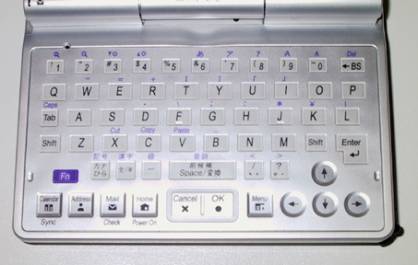
There is a row along the top for number keys and a backspace key. In the
lower right area there is an inverted ‘T’ grouping of arrow keys. In the lower
left area there 4 keys; one for the Calendar, Address, Mail apps, and the Home
window. In the middle under the spacebar key are ‘Cancel’ and ‘OK’ keys.
Since the keyboard is small there is a function ‘Fn’ key that when pressed in
combination with other keys gives you other symbols, characters, and functions
like ‘cut’, ‘copy’, and ‘paste’.
The keyboard is too small for real touch-typing unless you really have tiny
fingers, I’ve found that you can either do the old ‘hunt & peck’ approach with
your 2 index fingers or if you hold the C760 in your hands you can use the
keyboard as a thumb-board, typing with your 2 thumbs.
As the C760 was designed for the Japanese market there are a few keys that have
Japanese characters on them. But all in all, it looks like a English keyboard.
SHELL
The exterior of the C760 is nicely finished and looks and feels like a quality
unit. The casing around the display half appears to be a painted metal (white)
and the other half with the keyboard/battery/slots appears to be a combination
of silver (painted?) plastic with a white plastic on the bottom that covers the
battery. The white plastic cover has a sliding lock/unlock switch on the bottom
that allows you remove the cover to get to the battery or used as part of the
soft or hard reset process if needed.
The display half of the unit feels very sturdy and I’ve not noticed any creaking
noises in opening or doing the ‘flip & twist’ motion.
The screen hinge is very good, smooth acting and feels very solid. Unlike most
full-size laptops that latch shut, the C760 has a spring-loaded hinge and closes
securely that way.
There are 2 LED indicator lights near one end of the hinge. One LED lights when
the AC power cord is plugged in to show that the battery is charging. Not 100%
sure about the other light, but it has an envelope icon next to it, so it might
relate to email?
WiFi
One very pleasant surprise compared to some other PDA platforms I’ve had is the
ease of setting up for WiFi use. According to some of the Zaurus websites that
are tracking compatibility of WiFi and storage cards, a lot of the commonly
available WiFi cards will work out of the box with the C760.
I found that the D-Link Air DCF-660W CF WiFi card was automatically recognized
by my C760. I did not need to install any software drivers!
In the Network app there is a network connection ‘setup wizard’ button, but
unfortunately, that opened up a window in Japanese. So, instead I used the setup
a ‘New’ connection button and filled in the needed info and soon I was connected
to my Apple AirPort wireless network and surfing away!
Well, enough about hardware, onto software…..
Software Included In ROM
The included software is organized into several groupings using tabs. I think
most of you PDA users reading this will be able to figure out what most of the
apps listed below do. So I’ll only add some notes to those you might not know.
One interesting thing is that when I’ve added new programs they put themselves
in the right tab automatically.
In the Applications tab there are the following apps:
Calendar
Contacts
ToDo List
Text Editor
EMail
NetFront v3.0 (web browser)
Music Player
Video Player
HancomSheet (spreadsheet/MS Excel )
HancomWord (word processing/MS Word)
Presentation (MS PowerPoint files)
ImagePad (photo viewer)
Voice
Calculator
CityTime
Clock
Help Browser
Camera
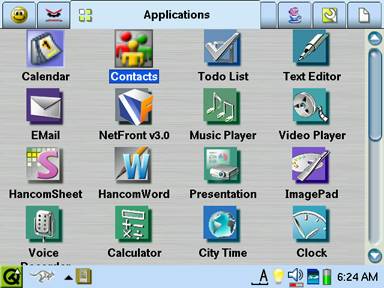
In the Settings tab there are the following apps:
Light & Power
Sound Settings
Tab Setting
Appearance
Network
Add/Remove Software
Security
Recalibrate
Applications Key
Date/Time
UserDic
Backup Restore
System Info
Migration
Receive Data
PC Link
Beam Receive
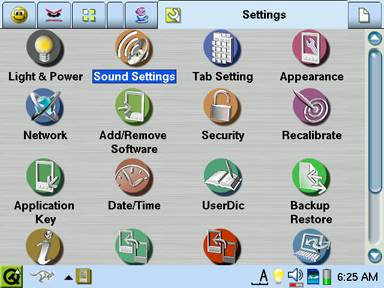
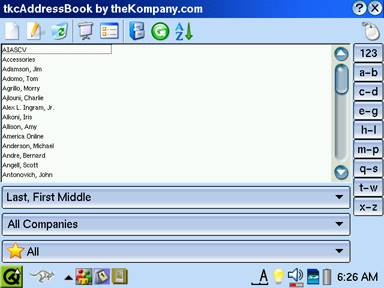
3rd Party AddressBook by theKompany.com replaces Contacts program
The photo above shows the Contacts replacement app by theKompany.com. Since it
replaces the Contacts app I can’t show you a photo of that app.
Likewise, I use the theKompany.com’s Calendar program so the photo below is of
that instead of Sharp’s Calendar app.
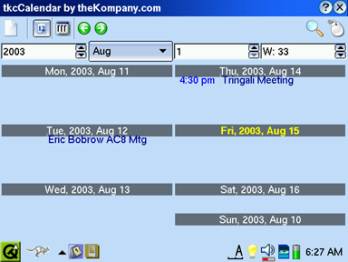
Week view shown – Other views available
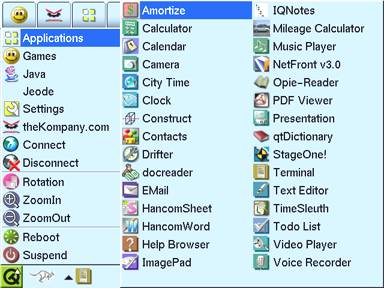
Another way to access programs is similar to the Start pop-up menu in Windows
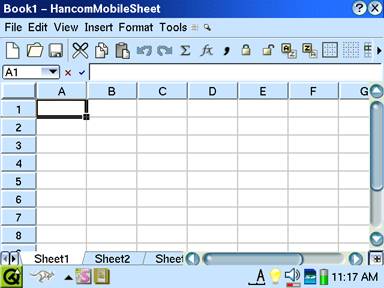
Hancom MobileSheet – Excel compatible spreadsheet program included
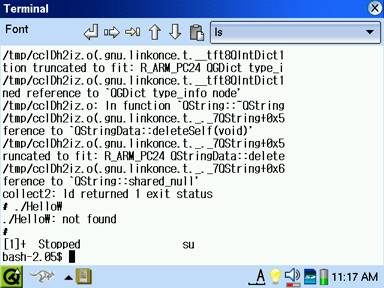
Terminal app for the Linux geeks out there
Optional Programs Installed by User from CD
Terminal
Qtopia Desktop (Windows PC sync app – Japanese – sync w/ Outlook or Palm
Desktop)
BackupRestore (Windows PC backup & restore app- English version available*)
FileManager (Windows Pc file transfer app – English version available*)
*English version available by downloading apps for US market Zaurus models
SL5500-5600 from Sharp.
WARNING!
This is not your typical PDA!
The SL-C760 (& C750) are NOT manufactured for sale outside of Japan. This a
JAPANESE MARKET unit! Therefore, one needs to understand and accept what this
means if you’re going to be a happy camper with the C760.
Since this is a JAPANESE MARKET model, it operates out of the box in JAPANESE!
So unless you want a Japanese language PDA, you need to either convert it to run
in English or buy one already converted for you.
Fortunately, it is possible to buy a SL-C760 already converted to English
through Dynamism.com.
The other non-recommended option for most users is to buy it directly from Japan
(Conics.net is where I got mine) and convert it your self. However, unless you
have advanced computer skills, preferably knowledge of Unix/Linux, config files,
and using a terminal app, I’d strongly recommend that you pay the extra dollars
and buy it already converted from Dynamism.
While it is tempting to try and save some money, I can tell you from personal
experience it isn’t worth the hassle or potential of creating a very expensive
doorstop if you screw it up badly!
Also, you if you buy one from overseas, you need to verify the warranty
situation. For example, if I need warranty service, I’ll need to send my C760
back to Conics.net in Japan. While with Dynamism, they will try to service at
their US facility first, if needed they will ship to Japan for you and send it
back to you.
CONCLUSION
All in all, this is great PDA or mini computer depending on how you want to look
at it or use it!
The C760 does pretty much everything you’d want to do with a PDA. There is also
a surprising amount of good 3rd party apps if you want more features than what
comes with the Zaurus. Although as noted, it comes with a pretty extensive set
of apps.
Also, there is a fairly large Zaurus user community out there (due to the US
market models SL5500/5600), once you start looking around for it. While they’re
different designs, there’s still a lot of similarity so I’ve gotten a lot of
good input from various Zaurus users. Check out zaurususergroup.com if you are
interested for starters.
For me the ability to use it like a little laptop or a traditional ‘palm-like’
PDA is great and I’ve really enjoyed using my C760 for the past month and a
half. Like any PDA there’s a few issues with it but nothing that critical for
me.
There has been talk that Sharp may release models like this in the US but
nothing definite has ever been announced. One can only hope that Sharp will
realize that there is a market in the US for a powerful device like this and
release an English version soon!
In the meantime, if you want a powerful little mini-computer that will fit in
most shirt pockets this is the one!
Price:
$799.00 C760 (Dynamism, converted to English)
$699.00 C750 (Dynamism, converted to English)
$599.00 C700 (Dynamism, converted to English)
Pros:
Very good performance
Lots of internal memory
SD and CF slots
Great vivid color screen indoors
Usable keyboard
Lots of included programs
User replaceable battery
Linux based, so can be used like laptop computer
Multiple apps can be open at one time
Cons:
Japanese Market Model
Screen dim outdoors
Cheap Stylus
No official Mac support
Android 13 Barcode Scanner Handheld Mobile Computer, 5.5-inch Touchscreen PDA Scanner with Integrated Honeywell 1D & 2D Bar Code Scan Engine, WiFi & 4G LTE, for Warehouse & Logistics
$399.99 (as of October 6, 2025 23:44 GMT -04:00 - More infoProduct prices and availability are accurate as of the date/time indicated and are subject to change. Any price and availability information displayed on [relevant Amazon Site(s), as applicable] at the time of purchase will apply to the purchase of this product.)MUNBYN IPDA101P Upgraded Android 13 Barcode Scanner with Pistol Grip, Wi-Fi 6 Handheld Mobile Computer PDA 5.5" Screen, Equipped Data Terminal SE4710 Zebra Engine, GPS 1D/2D/QR Inventory Scanner
$655.45 (as of October 6, 2025 23:17 GMT -04:00 - More infoProduct prices and availability are accurate as of the date/time indicated and are subject to change. Any price and availability information displayed on [relevant Amazon Site(s), as applicable] at the time of purchase will apply to the purchase of this product.)Product Information
| Price: | 799.0 |
| Manufacturer: | Sharp |
| Pros: |
|
| Cons: |
|



Gadgeteer Comment Policy - Please read before commenting
Post your comments here on the Sharp Zaurus C760 Review.
http://www.the-gadgeteer.com/sharp-zaurus-c760-review.html
Just click the POST REPLY button on this page.
Since I did the review of the C700 Zaurus in January, and have
myself upgraded to the C760, I thought I’d mention a few
things to watch out for. The C700, like earlier Sharp Linux
machines, used Jeode Java, and many applications I use on the
machine are written for Jeode. The C760 switched to Sun’s
Personal Profile java, and put a script in bin that’s supposed to
tell applications looking for Jeode’s evm to use Sun’s cvm
instead. THIS IS A BUGGY SCRIPT, it doesn’t run. I ended up
installing Jeode as a second java virtual machine on my C760.
I’ve noticed that in the past week a few of the applications on
the zaurus software site have been upgraded to run under cvm,
but one of the developers of a symbolic math program opined
that only Jeode is stable enough to run their programs on a
PDA. In any case, this is one exception to the usual finding that
5500 software will run on the C760. The other is Open Zaurus
applications, some of which don’t like the Sharp ROM (you can
change it to one of the custon ROMs if you’re a Linux cowboy).
The bigger battery is a real plus. During the recent blackout, we
had telephone service, and I picked up email and surfed using
my C760 with a Targus CF Pocket Modem. I also have a small
Radio Shack 23-047 compact Battery pack (discontinued, I
think) with selectable voltage levels, it is rated at over 2X the
C760 big battery and will run it at the 4.5 volt setting.
There is lots of free software I recommend very highly. The free
version of NeoCalc does RPN entry math, and the JustReader
is an excellent text and ebook reader, the C760’s sharp
screen makes reading easy in either orientation. Also very good
during a power failure when reading a dead-tree book can be
hard on the eyes, even with a flashlight.
The CF camera takes pretty poor pictures, but is easier to use
if you change the way Dynamism installs the camera
application. If you hold the stylus on the icon for a few
seconds, a screen comes up which lets you check a box
“display with magnified screen.” This makes the image you see
on the C760 screen bigger for viewfinding.
Some trouble has been reported with Sandisk 256 meg SD cards.
I use the Lexar 512 Meg SD and have a 1 Gig Sandisk CF card
(which comes out when I use the camera, modem or wifi cards,
and thus has no installed software, only movies and mp3
operas for travel).
Linux newbies (like me!) should note that the cards come
formatted in FAT32, which means that both my windows
desktop and the C760 see them, but that some files, when
you move them to the CF or SD card, get their permissions and
cases of letters in filenames screwed up. I had trouble moving my
calendar from the C700 to the C760 for this reason, until I
figured out how to use the bash shell terminal to change cases
and permissions, now it works fine.
Jeff
Spencer Huang of Sharp, USA, has been trying to drum up developer support for a Mac OS X solution. You can see the fledgling projects on the Zaurus Dev forums, but none are complete.
My Toshiba e740 pocket pc is acting flaky, and I have the Best Buy warranty. I am close to moving to a Palm – but the idea of no multitasking, and not being able to store home AND work addresses in Palm OS bugs me. Missing Sync for Pocket PC works pretty well, but Best Buy’s stock of Pocket PC equivalent to the Toshiba is limited to the HP5555 – heavy. 🙁
Hi extremeSIMS,
Actually, there are several developers working on Mac OSX support. One that I’ve been in touch with is planning to release a solution very soon that will work with the US model Z’s like the 5500/5600 as I understand.
The issue with the newer Japanese models like I have (C760) is Sharp changed the data format. So the current solutions need to be updated to work with this new format.
I’ve offered to help with this updating and hope to start that real soon….obviously this will be a big help for me.
In the meantime, just having the OSX USB Network driver has been a lifesaver for moving files back and forth from Mac to Z….
You should try a Z…… 😉
HTH,
Mark
PocketMac had been working on a solution, but I’ve not heard anything. When I had a working Zaurus, I was thinking of Perl scripts to take the data, munge it to and from XML, and use SCP to sync. PITA, though, IMO.
I smashed my Zaurus’ screen…. WiFi CF card got caught between case and glass, and smash it went. 🙁 My warranty for the Zaurus that covers the screen kicks in next month. Thank goodness.
Hi extremeSIMS,
Yipes!
Hope you get your Z fixed!
Which model do you have?
Also, are you saying that PocketMac group are working on a sync for Zaureses???
Mark
I had the SL-5500. Have, I guess.
You know what’s sad? Despite the broken screen, I installed OpenZ, and then used VNC to control the device. I had to hardcode calibration, but once I did that, it worked like a charm.
Not much sense in it, but I wanted to see if it would work. 😉
Are any of the compact flash Bluetooth cards supported?
Yes, it’s possible….however, it seems you have to do some setup work….
Check it out at
http://www.zaurus.com/dev/board/index.php?act=ST&f=4&t=5029&
HTH,
Mark
😎
Great review. Can you post a picture side by side with a Pocket PC? I just want to get a feeling how big it actually is.
Thanks nobody!
Glad you enjoyed it.
I had meant to have a photo of my Z next to my Clie NZ90 but I sold my Clie about a week before the review. I forgot to take the photo before shipping it off…
Anyway, Julie was going to take some side by side photos and post for me….
Hopefully she’ll do that soon.
However, I can tell you that the C760 is a very nice compact size, fits in your hands easily, and most shirt pockets.
It’s only about 3.25″ Wide x 4.75″ Long x .9″ thick (w/large battery, but less w/smaller C750 battery).
HTH,
Mark
I saw this (http://www.compgeeks.com/details.asp?invtid=GPS-CFCMPK) over the weekend and I was wondering if it worked in the Zaurus?
I have an idea for an app the would need the power and flexibility of the C760.
Thanks,
P.
Hi paulg,
Don’t know for sure about that one, but here’s a forum with some GPS posts….several are listed that work with the Z’s….
http://externe.net/zaurus/forum/viewtopic.php?t=123&highlight=gps
HTH,
Mark
C760 Owner 🙂
How interesting!
Old and good idea never dies. Do you remember the HP 200-LX, pretty much like the Zaurus and Sony-alike?
I own one HP 200-LX, and it is still very usefull.
Best regards,
—Rei Vilo
rei_vilo:
I agree with you, I had several HP 200-LX’s and loved them! I don’t think the mini-laptop / clam shell design will never die.
Well, got the money back from the Zaurus I smashed. PDA insurance plans are a good thing.
I do wish something was out now for the Zaurus to sync with Mac OS X. I could script up some hodge-podge work arounds, but that’s my limit. I can’t code in C or C++. 🙁
There is a Qtopia desktop now for Mac OS X, but I would rather have ti sync with iSync and the iCal trio.